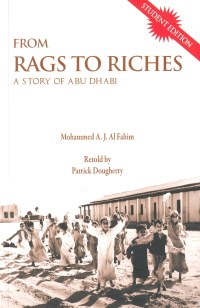From Rags to Riches
Neil Mcbeath, Oman

From Rags to Riches; A Story of Abu Dhabi – Student Edition
Mohammed A.J. Fahim 2001
Abu Dhabi; UAE Makazem Books
Pp. 109 ISBN 978 9984 16 330 5
I began teaching EFL in 1974, working for a deeply unpleasant Senior Lecturer who never used graded readers, preferring instead to issue class sets of Durrell’s (1956) My Family and Other Animals. Even at career entry (Woodward 2010), I questioned the use of that book. It is entirely suitable for bright native-speaking 12 year olds, but it seemed an insensitive choice. The summer of 1974 saw the fall of the Greek Colonel’s regime, and that autumn we had an influx of Greek students. How, I wondered, did they feel when a highly eccentric English family from the 1930s was held up as the norm, and their Corfiot compatriates were cast in roles of amusing foreigners? Certainly no competent teacher would be so crass as to offer such material today.
And that brings me to the book under review. Mohammed al Fahim is now a fabulously wealthy businessman from the United Arab Emirates, but he was born in 1948 and so he remembers the days when Abu Dhabi had nothing. “Life in Abu Dhabi at the time of my birth was the same as it had been in 1800” (P. 32)
From Rags to Riches is his autobiography, first written in Arabic, then retold by Patrick Dougherty, and now reissued in a simplified Student Edition format as an initiative by Melanie Gobert. This version of the book is designed for use with tertiary level students at the Emirates Higher Colleges of Technology.
The book therefore breaks new ground. It is simultaneously a graded reader and original work. It provides reading practice – but nothing more. There are no exercises, and it has only the briefest, one-page, English-English glossary (P. 109).
At the same time, the book is deeply rooted in the culture of the students for whom it is intended. Mohammed al Fahim is telling a story whose background details can be authenticated by the grandparents of the current UAE students – the so-called “Generation Y” (Reilly 2012). These students have grown up in the UAE that al Fahim saw being created, and his photographs (Pp. 43-66) show developments that must be unrivalled in world history. Simply compare the crude, bungalow sized Abu Dhabi Airport in 1961 (P. 48) with the three kilometers of air-conditioned, reflective glass, marbled luxury of the current airport and my point is proved.
Even so, Al Fahmi’s journey was not easy. The eldest son of a “merchant” who was little more that a shop keeper, he was fortunate in having a father who had some education. That education won the trust of Sheikh Zayed al Nahyan. Although Sheikh Zayed was the younger brother of Sheikh Shakbut, the Ruler of Abu Dhabi, he was the brother who had vision, and ultimately he became the founding father of the UAE.
Al Fahmi himself received a very basic Islamic education in a one-room schoolhouse, before being sent to England aged 16 – sponsored by Sheikh Zayed. Before that, his life had been basic. He recalls, with touching naivety, how impressed he was when, aged 13, he visited an oil drilling camp on Das Island. “They had piped water, showers and towels. I had never owned a towel. Here they had towels for everyone.” (P 73)
He also recalls once asking his father for some money, and being given what was literally the man’s last rupee. This story has greater resonance when we learn that, in 1994, the Al Fahim company opened the Dubai Holiday Centre (Photographs Pp. 61-62) which was built at a cost of 77.5 million pounds.
From Rags to Riches is not, therefore, an exaggerated title. It is a celebration of one businessman’s career, but it is also the story of that man’s nation. It tells of a bedu society that has demonstrated what has been called “the power of accommodation” (Raban 1979; 154) ; the ability to meet the 20th and 21st centuries head on, and sift through what they offer for what can be used most constructively.
From Rags to Riches is guaranteed to be a thoroughly engaging book for its intended audience in the UAE. Indeed, if the students read nothing else, they will read this. It ought to have almost the same impact on students from other Arab Gulf countries, but I would suggest that even European, South American or South east Asian students, this is a book which combines human interest with social insight.
I cannot recommend it highly enough.
References
Durrell, G. (1956) My Family and Other Animals. London. Rupert Hart-Davies.
Raban, J. (1979) Arabia. London. Orion.
Reilly, P. (2012) Understanding and Teaching Generation Y. English Teaching Forum
50/1. 2-11.
Woodward, T. (2010) The Professional Life Cycles of Teachers. Plenary presentation delivered at the 44th International IATELF Conference, Harrogate, 7-11, 2010. In
Tania Pattison (ed.) (2011) IATEFL 2010; Harrogate Conference Selections. Canterbury; Kent. IATEFL. 40-45.

Please check the British Life, Language and Culture course at Pilgrims website.
Please check the Methodology and Language for Secondary Teachers course at Pilgrims website.


|